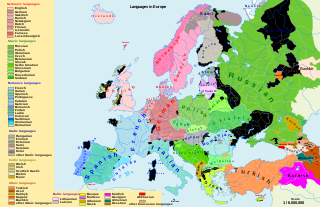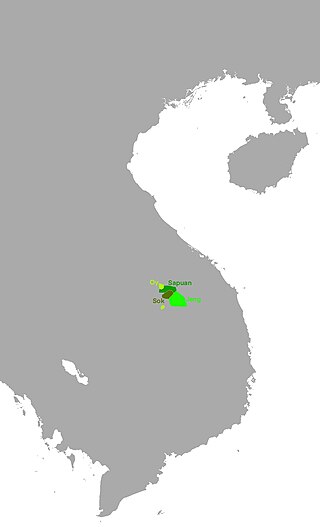Related Research Articles

There are over 250 languages indigenous to Europe, and most belong to the Indo-European language family. Out of a total European population of 744 million as of 2018, some 94% are native speakers of an Indo-European language. The three largest phyla of the Indo-European language family in Europe are Romance, Germanic, and Slavic; they have more than 200 million speakers each, and together account for close to 90% of Europeans.
Central Ibibio is the major dialect cluster of the Cross River branch of Benue–Congo. Efik proper has national status in Nigeria and was erroneously made the literary standard of the Ibibio language, though Ibibio proper has more native speakers.
Mapoyo, or Mapoyo–Yavarana, is a Carib language spoken along the Suapure and Parguaza Rivers, Venezuela. The ethnic population of Mapoyo proper is about 365. Yabarana dialect is perhaps extinct; 20 speakers were known in 1977. An additional dialect, Pémono, was discovered in 1998. It was spoken by an 80-year-old woman and has since gone extinct.

Oi is an Austroasiatic dialect cluster of Attapeu Province, southern Laos. The dominant variety is Oy proper, with 11,000 speakers who are 80% monolinguals. The Jeng (Cheng) speak the same language but are ethnically distinct. Speakers follow traditional religions.
Ini is located in the south of Nigeria and is a local government area of Akwa Ibom State.
Yaka, also spelled Iaca and Iyaka, is a Bantu language spoken in the Democratic Republic of the Congo and Angola. There are two dialects, Yaka proper, which comprises 99% of speakers, and Ngoongo. The alleged varieties Pelende and Lonzo are political rather than ethnolinguistic entities.
Ta'Oi is a Katuic dialect chain of Salavan and Sekong provinces in Laos, and in Thừa Thiên-Huế province in Vietnam.
Phola, or Upriver Phula, is a dialect cluster of the Loloish languages spoken by the Phula people of China.
Kaba proper is a Bongo–Bagirmi language of Chad and the Central African Republic. It is one of several local languages that go by the names Kaba and Sara. There are three ISO codes, which Ethnologue acknowledges may be the same thing.
The Ayizo languages (Ayizɔ) are Gbe languages spoken in Benin. They are Ayizo, Kotafon, and Gbesi.
Ali (’Àlī) is a Gbaya language of the southwestern Central African Republic. Ngbaka Manza is closer to ’Ali proper than it is to its namesakes Manza or Ngbaka, though all may be mutually intelligible to some extent.
Faiwol is one of the Ok languages of Papua New Guinea. It is spoken at the headwaters of the Fly, Palmer, and Murray rivers in Western Province. There are numerous dialects, including Faiwol proper, Angkiyak, Wopkei, Setaman, Selbang, Dimtikin, and Kauwol on the Indonesian border.
Kayan is a dialect cluster spoken by the Kayan people of Borneo. It is a cluster of closely related dialects with limited mutual intelligibility, and is itself part of the Kayan-Murik group of Austronesian languages.
Mumeng is a dialect chain of the Austronesian family in Morobe Province, Papua New Guinea. Dambi–Kumalu and Patep–Zenag–Gorakor have a degree of mutual intelligibility. Kapin may belong as well.
Gurdjar (Kurtjar) is a Paman language of the Cape York Peninsula, Queensland, Australia. There are two dialects, Gurdjar proper, and Rip. According to the UNESCO Atlas of the World's Languages in Danger, the language is classified as extinct.
Mfumte (Nfumte) is a Grassfields Bantu language of Cameroon. It is not clear if the four varieties spoken by ethnic Mfumte—Ndaktup, Kwaja, Fum and Mfumte proper—are mutually intelligible or distinct languages; ability to communicate may be either due to inherent intelligibility or to bilingualism, while Fum and Mfumte may simply be the Nigerian and Cameroonian names for the same language.
West Arawe is an Austronesian dialect chain of West New Britain, Papua New Guinea. The principal varieties are Apalik, Gimi, Aiklep, and Arawe proper (Solong).
Kimaragang (Marigang), Tobilung, and Rungus are varieties of a single Austronesian language of Sabah, Malaysia. The three varieties share moderate mutual intelligibility. Children are not learning it well in some areas.
Silacayoapan is one of the more extensive Mixtec languages. It is spoken by 150,000 people in Puebla and across the border in Guerrero, as well as by emigrants to the United States.
Uzo or Uzō may refer to:
References
- ↑ Ibuoro proper at Ethnologue (18th ed., 2015) (subscription required)
Ito at Ethnologue (18th ed., 2015) (subscription required)
Itu Mbon Uzo at Ethnologue (18th ed., 2015) (subscription required)
Nkari at Ethnologue (18th ed., 2015) (subscription required)